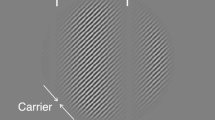Abstract
It has been suggested for a number of years that ganglion cells inform the rest of the brain about contrast in the retinal image. The purpose of the work undertaken here was to demonstrate this fact explicitly. Extracellular recordings were made from X- and Y-cell axons of the optic tracts of anesthetized cats. Responses of these cells to gratings that were near optimal in spatial and temporal frequency were measured for a range of contrasts. For each cell, similar measurements were made at a number of light levels, spanning the photopic to high scotopic (inclusive) ranges. A monotonie relationship between response and contrast was found at all light levels studied, and the same relationship was retained to a good approximation across all light levels. A similar result was also found when nonoptimal spatial frequencies were used as stimuli. These results indicate strongly that X and Y cells inform the cat's brain about contrast in the retinal image. It was also observed that the mean discharge rate of X and Y cells did not change with light level, indicating that no information is relayed to the brain by these cells on the mean light level.
Similar content being viewed by others
References
Barlow HB (1972a) Single units and sensation: a neuron doctrine for perceptual psychology? Perception 1:371–394
Barlow HB (1972b) Dark and light adaptation: psychophysics. In: Jameson D, Hurvich LM (eds) Handbook of sensory physiology, vol VII/4. Springer, Berlin Heidelberg New York, pp. 1–28
Barlow HB, Levick WR (1969) Three factors limiting the reliable detection of light by retinal ganglion cells of the cat. J Physiol 200:1–24
Barlow HB, Levick WR (1976) Threshold setting by the surround of cat retinal ganglion cells. J Physiol 259:737–757
Berkley MA (1976) Cat visual psychophysics: neural correlates and comparisons with man. Progr Psychobiol Physiol Psychol 6:63–119
Chan LH, Freeman AW, Cleland BG (1992) The rod-cone shift and its effect on ganglion cells in the cat's retina. Vision Res 32:2209–2219
Cleland BG, Enroth-Cugell C (1968) Quantitative aspects of sensitivity and summation in the cat retina. J Physiol 198:17–38
Cleland BG, Enroth-Cugell C (1970) Quantitative aspects of gain and latency in the cat retina. J Physiol 206:73–91
Cleland BG, Freeman AW (1988) Visual adaptation is highly localized in the cat's retina. J Physiol 404:591–611
Derrington AM, Lennie P (1982) The influence of temporal frequency and adaptation level on receptive field organization of retinal ganglion cells in cat. J Physiol 333:343–366
Enroth-Cugell C, Robson JG (1966) The contrast sensitivity of retinal ganglion cells of the cat. J Physiol 187:517–552
Enroth-Cugell C, Robson JG (1984) Functional characteristics and diversity of cat retinal ganglion cells. Invest Ophthalmol Vis Sci 25:250–267
Enroth-Cugell C, Shapley RM (1973) Flux, not retinal illumination, is what cat retinal ganglion cells really care about. J Physiol 233:311–326
Enroth-Cugell C, Hertz BG, Lennie P (1977a) Cone signals in the cat's retina. J Physiol 269:273–296
Enroth-Cugell C, Hertz BG, Lennie P (1977b) Convergence of rod and cone signals in the cat's retina. J Physiol 269:297–318
Enroth-Cugell C, Goldstick TK, Linsenmeier RA (1980) The contrast sensitivity of cat retinal ganglion cells at reduced oxygen tensions. J Physiol 304:59–81
Enroth-Cugell C, Robson JG, Schweitzer-Tong DE, Watson AB (1983) Spatio-temporal interactions in cat retinal ganglion cells showing linear spatial summation. J Physiol 341:279–307
Frishman LJ, Freeman AW, Troy JB, Schweitzer-Tong DE, Enroth-Cugell C (1987) Spatiotemporal frequency responses of cat retinal ganglion cells. J Gen Physiol 89:599–628
Hammond P, Mouat GSV (1985) The relationship between feline pupil size and luminance. Exp Brain Res 59:485–490
Harding TH (1977) Field adaptation and signal summation within the receptive field center of cat retinal ganglion cells. PhD thesis. Purdue University Indiana, USA
Hochstein S, Shapley RM (1976) Quantitative analysis of retinal ganglion cell classifications. J Physiol 262:237–264
Hubel DH (1982) Exploration of the primary visual cortex, 1955–78. Nature 299:515–524
Lennie P (1979) Scotopic increment thresholds in retinal ganglion cells. Vision Res 19:425–430
Purpura K, Kaplan E, Shapley RM (1988) Background light and the contrast gain of primate P and M retinal ganglion cells. Proc Natl Acad Sci USA 85:4534–4537
Rushton WAH (1969) Light and dark adaptation of the retina. In: Reichardt W (ed) Processing of optical data by organisms and by machines. Academic, New York, pp 544–564
Saito HA, Fukada Y (1986) Gain control mechanisms in X- and Y-type retinal ganglion cells of the cat. Vision Res 26:391–408
Sakmann B, Creutzfeldt OD (1969) Scotopic and mesopic light adaptation in the cat's retina. Pflügers Arch 313:168–185
Shapley RM, Enroth-Cugell C (1984) Visual adaptation and retinal gain controls. Prog Retinal Res 3:263–343
Shapley R, Lennie P (1985) Spatial frequency analysis in the visual system. Annu Rev Neurosci 8:547–583
Shapley RM, Victor JD (1978) The effect of contrast on the transfer properties of cat retinal ganglion cells. J Physiol 285:275–298
Sterling P (1990) Retina. In: Shepherd GM (ed) The synaptic organization of the brain, 3rd edn. Oxford University Press, Oxford, pp 170–213
Stone J, Fukuda Y (1974) Properties of cat retinal ganglion cells: a comparison of W-cells with X- and Y cells. J Neurophysiol 37:722–748
Tessier-Lavigne M (1991) Phototransduction and information processing in the retina. In: Kandel ER, Schwartz JH, Jessell TM (eds) Principles of neural science. 3rd edn. Elsevier, Amsterdam, pp 400–418
Troy JB, Robson JG (1992) Steady discharges of X and Y retinal ganglion cells of cat under photopic illuminance. Visual Neurosci 9:535–553
Whittle P, Challands PDC (1969) The effect of background luminance on the brightness of flashes. Vision Res 9:1095–1110
Wilcox JG, Barlow HB (1975) The size and shape of the pupil in lightly anaesthetized cats as a function of luminance. Vision Res 15:1363–1365
Author information
Authors and Affiliations
Rights and permissions
About this article
Cite this article
Troy, J.B., Enroth-Cugell, C. X and Y ganglion cells inform the cat's brain about contrast in the retinal image. Exp Brain Res 93, 383–390 (1993). https://doi.org/10.1007/BF00229354
Received:
Accepted:
Issue Date:
DOI: https://doi.org/10.1007/BF00229354




